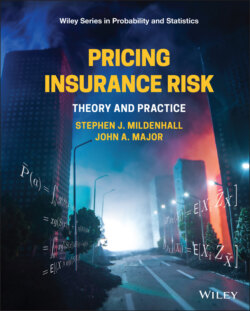Читать книгу Pricing Insurance Risk - Stephen J. Mildenhall - Страница 41
3.3.3 Types of Uncertainty
ОглавлениеProbabilities can be objective or subjective. Objective probabilities are amenable to precise determination. They are usually based on physical symmetry (coin toss, dice roll) or repeated observations. Objective probability applies the law of large numbers, the central limit theorem, Bayesian statistics, and credibility theory to make precise predictions about samples. Insurance is largely based on objective probabilities from repeated observations (loss data).
Subjective probabilities provide a way of representing a degree of belief. They follow the same rules as objective probabilities and have proven a powerful way to impose order and consistency in economics and finance. Subjective probabilities are applied to nonrepeatable events: an election, a horse race, or an economic outcome. Subjective probability is also used with game theory, nonadditive probability, and behavioral science to make predictions and understand uncertainty. Insurance largely avoids pricing based on subjective probabilities, as the problems with creating markets for terrorism and cyber risks attest.
The differences between objective and subjective probabilities, and their relations to the development of probability and adjacent theories in judgment, psychology, physics, inference, and statistics, are discussed in Diaconis and Skyrms (2018).
It is usual to distinguish process risk in the face of a well-defined (objective) probability model from uncertainty when there is no probability model or even no clearly defined set of possible outcomes. Process risk is also called a aleatoric uncertainty, derived from the Latin alea or dice. Uncertainty is sometimes called Knightian uncertainty after the economist Frank Knight. Epistemic uncertainty is caused by a knowledge gap, possibly one that could in principle be filled.
Parameter risk is intermediate between process risk and uncertainty. It refers to a known model with unknown parameters. Actuaries often use Bayesian models to introduce (and sometimes remove) parameter risk. There is a blurred line between parameter risk and uncertainty. For example, a parameter can be used to select between competing models.
A situation of unknown unknowns represents an extreme form of uncertainty.
These concepts and relationships are summarized in Figure 3.1.
Figure 3.1 Taxonomy of insurance-related risk.
Example 6 When the US National Science Foundation decided to fund the LIGO search for gravitational waves there was epistemic uncertainty since no one knew for sure whether gravitational waves existed. If they did exist, experiments to detect them would still be subject to process risk: the chance none would be detected because no events producing gravitational waves occur during the observational period. There is even operational risk, that the detector malfunctions and misses an event. P.S. It appears they do exist!
